Many years ago, I found a website that gave complete instructions on how to build a traditional Mongolian yurt, often called a ger. Something about its construction spoke to me deeply. I bookmarked the site never knowing that years later I would end up building it and living in it.
The yurt was created by nomads in Asia over 2000 years ago and many Asians still live in these today. Within its walls lay very important lessons about nature and systems. The yurt is highly portable and is made of several components that act together to make the home structurally sound. Leave one piece out, and it topples like a house of cards.
 Two Christmas’s ago, I was hired to perform my show at a theme park located in the deserts of Arizona. At least they told me it was a theme park - more on this later. Most parks I work normally help me set up living arrangements because I work on location for a few months at a time. In the contract I noted that I had been giving a campsite. Well, it wasn’t a house, but I enjoyed the idea of roughing it for a couple of months. This was when I remembered the yurt. Yep, this was it. “I’m going to build a yurt.”
Two Christmas’s ago, I was hired to perform my show at a theme park located in the deserts of Arizona. At least they told me it was a theme park - more on this later. Most parks I work normally help me set up living arrangements because I work on location for a few months at a time. In the contract I noted that I had been giving a campsite. Well, it wasn’t a house, but I enjoyed the idea of roughing it for a couple of months. This was when I remembered the yurt. Yep, this was it. “I’m going to build a yurt.”
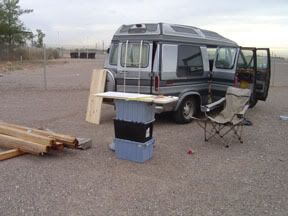 I arrived a week early for the gig; which was cutting it close by my standards. I had eight weeks until I went back home and I expected to have this thing built in two weeks.
I arrived a week early for the gig; which was cutting it close by my standards. I had eight weeks until I went back home and I expected to have this thing built in two weeks.
Convincing the park to let me build my yurt was no easy task. First off, they had no clue what one was. After many strange and angry looks, I won and they gave me a spot at the very back, away from everyone, to build. Just how I like it.
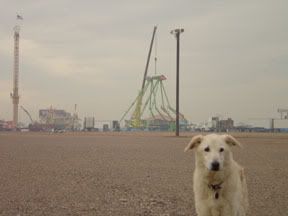 This was my first look at the theme park. I quickly realized that I had been misled and this was no theme park. It was a carnival. A really big carnival calling itself a theme park. There are huge differences that I will not go into to. I had never worked a carnival and I knew this was going to be interesting; but that’s another story.
This was my first look at the theme park. I quickly realized that I had been misled and this was no theme park. It was a carnival. A really big carnival calling itself a theme park. There are huge differences that I will not go into to. I had never worked a carnival and I knew this was going to be interesting; but that’s another story.
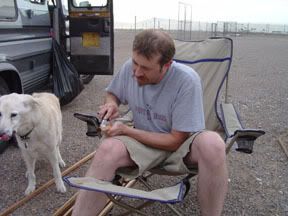 The carnival opened and I moved my construction site to behind my stage. I performed 3-4 shows a day and I spent every daylight hour, behind my stage, mostly tieing knots. Thousands and thousands of knots. These knots had to be tight so I would wrap nylon string around a pair of pliers to keep it tight. This resulted in me getting stitches right before a show; the string broke and I whacked my face with the pliers. Running close to show time, I had to skip out of the hospital without filing the paperwork and my show five started 5 minutes late. It made a funny moment when I had my assistant come out and cut the hospital band from my wrist in front of the audience. Jen, my assistant, later cut my stitches out backstage.
The carnival opened and I moved my construction site to behind my stage. I performed 3-4 shows a day and I spent every daylight hour, behind my stage, mostly tieing knots. Thousands and thousands of knots. These knots had to be tight so I would wrap nylon string around a pair of pliers to keep it tight. This resulted in me getting stitches right before a show; the string broke and I whacked my face with the pliers. Running close to show time, I had to skip out of the hospital without filing the paperwork and my show five started 5 minutes late. It made a funny moment when I had my assistant come out and cut the hospital band from my wrist in front of the audience. Jen, my assistant, later cut my stitches out backstage.
 During the build, I made two new friends: Jay and Mike, who are among the few full blooded Apache left. They commented on how my door faced east and never referred to the yurt, it was always a hogan to them. We hung out in the hogan often and used it for what hogans are used for. Good medicine.
During the build, I made two new friends: Jay and Mike, who are among the few full blooded Apache left. They commented on how my door faced east and never referred to the yurt, it was always a hogan to them. We hung out in the hogan often and used it for what hogans are used for. Good medicine.
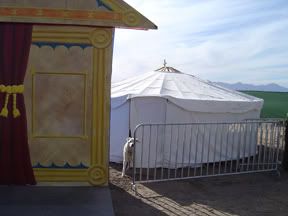 I finished the yurt on December 24th, 2005. It took me 5 weeks to build. They let me keep it behind my stage. I lived in it until the end of the run and returned the following winter and lived in it for the entire 2006-2007 season. It was nice being home, then taking a few steps and being on stage at work. Other entertainers would stop by while going or coming from their own stages to keep warm. My place was the warmest spot on the midway. (These were winter evening showing in the AZ desert. It got quite cold sometimes.) Everyone one else, including the carnies, lived half a mile away at the campsite in motor homes, fifth wheels, bunk houses, and cargo trailers. They of course thought I was the crazy one.
I finished the yurt on December 24th, 2005. It took me 5 weeks to build. They let me keep it behind my stage. I lived in it until the end of the run and returned the following winter and lived in it for the entire 2006-2007 season. It was nice being home, then taking a few steps and being on stage at work. Other entertainers would stop by while going or coming from their own stages to keep warm. My place was the warmest spot on the midway. (These were winter evening showing in the AZ desert. It got quite cold sometimes.) Everyone one else, including the carnies, lived half a mile away at the campsite in motor homes, fifth wheels, bunk houses, and cargo trailers. They of course thought I was the crazy one.
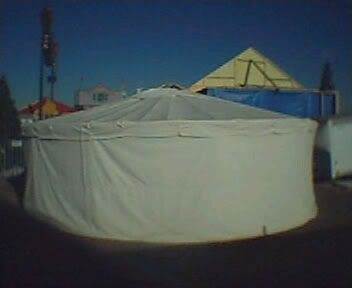 As you can tell, my stage was not very secure. It was a good thing that my dog and I were living right behind it. One morning I woke up and all my extension cords to the stage had vanished. They left the ones going to the yurt.
As you can tell, my stage was not very secure. It was a good thing that my dog and I were living right behind it. One morning I woke up and all my extension cords to the stage had vanished. They left the ones going to the yurt.
The yurt survived a wild wind storm that destroyed many other tents and structures on the lot. Everyone came around the next morning to see if I survived. They were surprised that my yurt sustained no damage at all. It wasn’t even tied down.

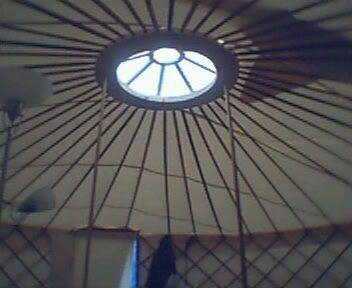
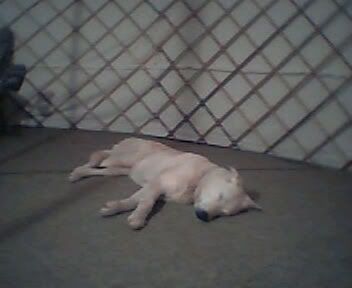
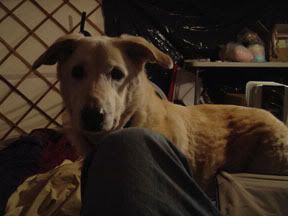
It was great living simply and I adapted quite easily. I didn’t have running water; but the knife throwers’ stage had a shower in the back and they let me use that. I would like to figure out how the nomads transported their stoves. One day I may tour across America in my yurt, working for blankets and food.
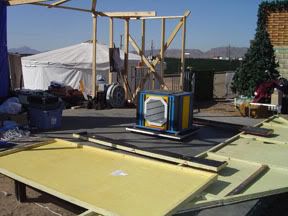
Tearing down the stage? or practicing a Buster Keaton routine?
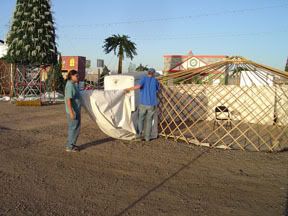
Yep, tearing down.

Finished and relaxing.

Ready to go home!
The hardest part of this project was sewing the top cover. The yurt is 18 feet in diameter and has a surface area of 254 square feet. At one point I was handling a peace of fabric that was over 200 square feet. It was tough getting that through my sewing machine. (Maybe I should have just bought a pool cover.) The original plans I followed were for a 10 foot diameter yurt; so I made a few calculations to get to this size. If you are interested in building your own yurt, this is where it starts: A complete guide to making a Mongolian Ger.